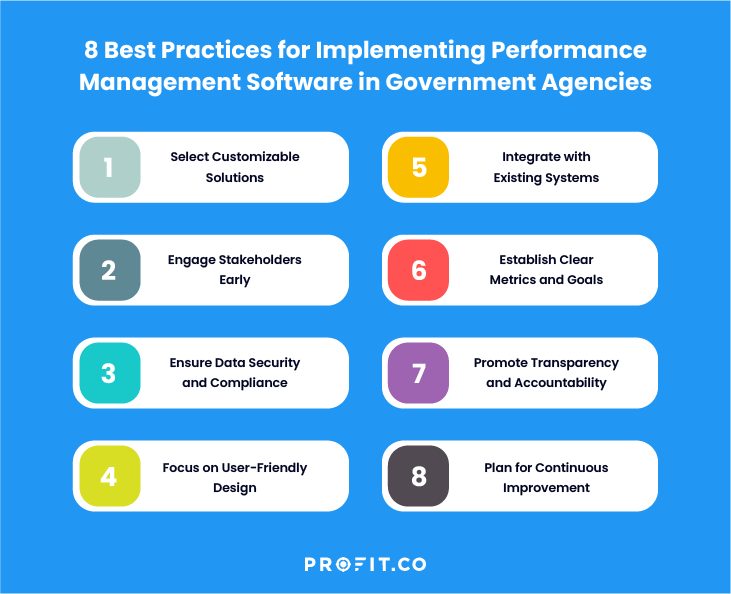Introduction
Improving government performance is no small task. Government agencies are complex, multi-layered organizations, and managing them effectively requires a comprehensive approach. The challenge lies in transforming strategic plans into tangible results that directly impact citizens’ lives. Implementing performance management software can be a game-changer in this regard, but it requires careful planning and execution to ensure success.
Understanding Government Performance Challenges
Government effectiveness and efficiency have many dimensions, but many of the problems in managing government performance stem from a few underlying causes. These causes are remarkably similar across different countries and governments, and they include
Fragmentation of Institutional Responsibility
Government departments often report to multiple principals with differing objectives, leading to unclear goals and expectations. This fragmentation is further compounded when multiple agencies share responsibility for implementing initiatives, diluting accountability and making it difficult to achieve cohesive results. Additionally, many performance management systems in government are built on rigid frameworks that do not easily adapt to changing needs or circumstances, hindering the ability to innovate and respond to new challenges.
Lack of Real-Time Reporting
Performance reporting in government is frequently selective and delayed, rendering it ineffective in addressing current challenges. The dispersed nature of teams and the involvement of multiple departments exacerbate these delays. Moreover, performance data is often siloed in separate, non-integrated systems, making it difficult to obtain a comprehensive view of overall government performance. This lack of integration leads to inefficiencies and hampers coherent decision-making.
Boost your agency’s performance
Flaws in Existing Performance Systems
Many performance management systems in government are fundamentally flawed, lacking critical elements such as incentives, prioritization of objectives, and comprehensive evaluations. These systems often overemphasize quantitative metrics such as numbers and percentages while neglecting qualitative factors like employee satisfaction, innovation, and public perception. This narrow focus results in a limited understanding of true performance and effectiveness.
Limited Employee Engagement
Existing performance management systems are frequently designed with a top-down approach, where goals and metrics are set by senior management with minimal input from employees. This can lead to disengagement and a lack of ownership among the workforce. Additionally, government employees often receive insufficient training on how to use these systems effectively. Without ongoing support and development, the systems may be underutilized or misused, further undermining their effectiveness.
To effectively address these challenges and drive meaningful improvements, government leaders must not only identify and understand the root causes of poor performance but also leverage the right tools and strategies to implement change. One of the most powerful tools at their disposal is performance management software, which, when implemented using best practices, can transform these insights into actionable improvements that enhance overall government effectiveness.
No company,small or large,can win over the long run without engergized employees who believe in the mission and understand how to achive it
Implementing Performance Management Software in Government Agencies
Select Customizable Solutions to Public Sector Needs
Select Customizable Solutions to Public Sector Needs
When selecting performance management software, it’s crucial to choose a solution that can be tailored to meet these specific government mandates, such as adherence to the Federal Information Security Management Act (FISMA) or other regulatory frameworks.
Customization should also extend to tracking and reporting public-facing outcomes, ensuring that the software can support transparency and fulfill the agency’s accountability obligations to citizens and oversight bodies.
Engage Stakeholders Early
In government, decisions often impact a wide array of stakeholders, from department heads and IT teams to frontline employees and union representatives. Engaging these stakeholders early in the software selection process ensures that the chosen solution aligns with the agency’s strategic priorities and operational needs. This collaborative approach also helps secure buy-in across the organization, which is essential for successful implementation in the often hierarchical and procedurally driven environment of government agencies.
Implementing Performance Management Software in Government AgenciesEnsure Data Security and Compliance
Government agencies are custodians of highly sensitive information, ranging from personal data of citizens to national security details. Therefore, data security is non-negotiable.
The chosen performance management software must comply with stringent federal and state data protection regulations, such as the Health Insurance Portability and Accountability Act (HIPAA) for health data or the General Data Protection Regulation (GDPR) for any international data exchanges. Encryption, multi-factor authentication, and secure access controls are vital features to protect against data breaches and unauthorized access.
Additionally, the software must support compliance with legal standards for data storage, retrieval, and archiving to ensure that all records are managed according to government mandates.
Focus on User-Friendly Design
For performance management software to be effective in a government setting, it must be user-friendly enough to be adopted across a diverse workforce, which may include employees with varying levels of technical expertise. The interface should be intuitive, with clear instructions and accessible features that cater to the needs of all users from senior executives to frontline staff.
Given the procedural nature of government work, the software should simplify, rather than complicate, daily tasks. To ensure smooth adoption, provide extensive training programs tailored to different user groups, along with ongoing support that includes help desks, user guides, and regular refresher courses.
Integrate with Existing Systems
Government agencies often operate with a patchwork of legacy systems, each serving different functions such as HR management, financial accounting, and project tracking. The new performance management software must integrate seamlessly with these existing systems to avoid data silos and streamline workflows.
For instance, integration with a government agency’s HR database should enable automatic updates of employee records, while connection to financial systems can facilitate budget tracking against performance outcomes. Before full-scale implementation, conducting a pilot test is crucial to identify any integration challenges and ensure the software can function harmoniously within the existing IT infrastructure.
Establish Clear Metrics and Goals
In the public sector, success is measured not only by efficiency and productivity but also by how well an agency meets its mandate to serve the public interest. Therefore, performance metrics should be clearly defined and aligned with the agency’s mission and strategic objectives.
For example, a Department of Health might measure success by tracking improvements in public health outcomes or the timeliness of service delivery.

Promote Transparency and Accountability
Government agencies operate under public scrutiny, making transparency and accountability paramount. Performance management software should be leveraged to provide real-time access to performance data for key stakeholders, including agency leadership, oversight bodies, and, where appropriate, the public.
This transparency can foster a culture of accountability, where employees are more likely to take ownership of their roles and responsibilities. Regular feedback sessions should be institutionalized, allowing managers and employees to review performance data, set realistic goals, and address any challenges promptly.
Plan for Continuous Improvement
In the dynamic environment of government, where policies, regulations, and public expectations are constantly evolving, performance management systems must be adaptable. Treat the implementation of performance management software as an ongoing journey rather than a one-time project. Regularly assess the system’s effectiveness, gather user feedback, and make iterative improvements to ensure the software continues to meet the agency’s needs.
Staying informed about the latest technology trends and advancements is also critical. This proactive approach ensures that the performance management system remains relevant, effective, and capable of supporting the agency’s mission over the long term.
Conclusion
Implementing performance management software in government agencies requires a thoughtful approach that addresses the unique challenges of the public sector. By focusing on these best practices, agencies can overcome common obstacles and significantly improve their operational efficiency and accountability. The journey to a more effective, responsive government begins with the right tools and strategies, and performance management software is a crucial component of this transformation.
To learn more about achieving continuous learning
Related Articles
-
Organizational Design and Capacity Planning: Building the ‘People’ Foundation of the Performance Triangle
All plans look promising on paper, but they don't always work out in real life. Plans tell you what you... Read more
-
How the Reflect and Reset Cycle Strengthens the Performance Triangle
High performance comes through consistent reflection. In the Performance Triangle, reflection is the invisible fourth element that keeps plans, processes,... Read more
-
The Performance Triangle vs. Traditional Performance Management
Let's talk about something that affects every business. It is also something that most people don't like, which is managing... Read more
-
How Consistent Cadence Keeps Performance Aligned
The Performance Triangle gives you the framework for high performance and governance, and with a consistent cadence, you have everything... Read more

